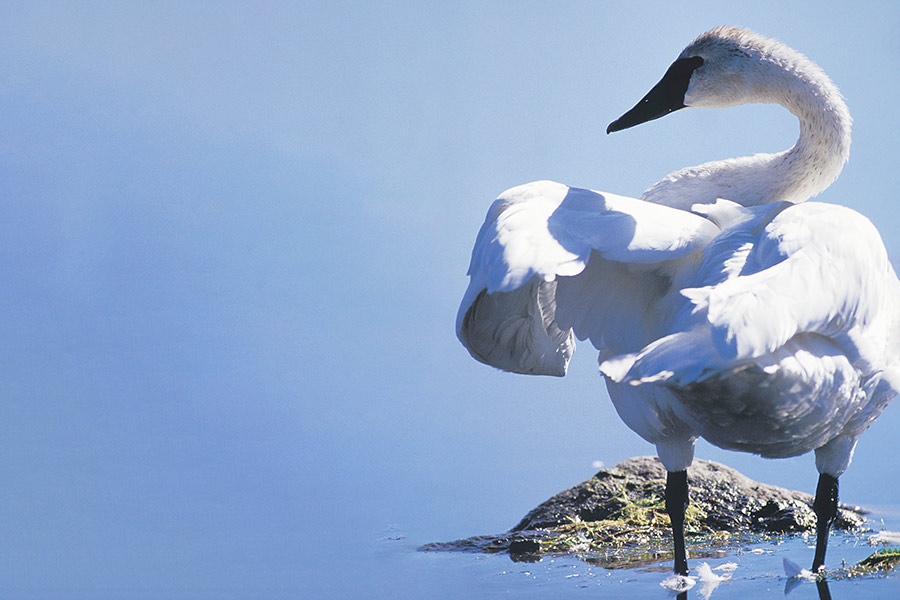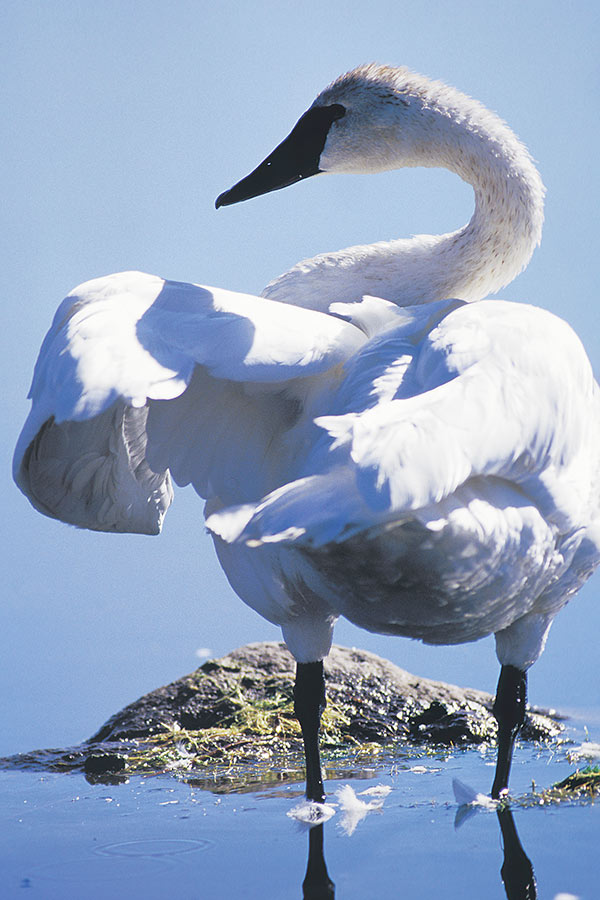Utah Wildlife Board votes to prohibit harvest of trumpeter swans, approves other changes to upland game and turkey hunting
Salt Lake City — The Utah Wildlife Board approved some changes to upland game hunting and waterfowl hunting — including making it illegal to harvest trumpeter swans — as well as changes to a few other items during a public meeting Thursday.
Changes to waterfowl and swan hunting
In 2019, swan regulations changed to expand the hunting boundaries in Box Elder County and to increase the total number of swan permits offered in Utah to allow for additional hunting opportunities. Since that change, the Utah Division of Wildlife Resources has had to close the swan hunting season early for the last four years, due to the federal quota of 20 trumpeter swans being met.
Utah is one of only nine states in the U.S. that allows hunting for swans. Due to the low population size of trumpeter swans in the Greater Yellowstone area, the U.S. Fish and Wildlife Service sets the annual harvest quota (currently 20 birds) for the number of trumpeter swans that can be harvested in Utah.
In an effort to prevent the swan hunting season from having to close early, the Utah Wildlife Board voted to prohibit the harvest of trumpeter swans in Utah. Only tundra swan hunting permits will be issued to hunters, and it will be illegal to harvest a trumpeter swan. Hunters will still be required to check in any harvested swans at a DWR office. Trumpeter swans will be seized, and the hunter may face a citation.
In December 2021, the Utah Wildlife Board voted to mandate a waiting period for anyone who harvests a trumpeter swan. The waiting period prevents hunters from obtaining another swan permit in Utah for five years, for adults, and for three years, for youth. That waiting period is still in effect, in addition to the new rule approved Thursday.
"We have seen a higher number of trumpeter swans harvested the last four years because there are more migrating through Utah than in previous years," Utah Division of Wildlife Resources Migratory Game Bird Program Coordinator Jason Jones said. "We are hopeful that this change will prevent hunting opportunities from being taken away due to the early-season closures."
A few other changes to waterfowl hunting were approved by the board as well, including updating the rule to allow electronic duck stamps, in accordance with recent legislative changes. In addition to having a hunting license, anyone hunting waterfowl in Utah is required to have a Harvest Information Program (HIP) number, and those 16 years of age or older are required to also have a federal duck stamp. Previously, duck stamps could only be purchased from a local post office, various license agents or by phone. HB341 is now in effect and authorizes the DWR to sell duck stamps online on the DWR website, in order to make transactions easier for hunters.
Another rule change that was approved during Thursday's meeting clarifies that dogs are allowed year-round in the Hasenyager Nature Preserve area of Farmington Bay (where the George S. and Dolores Doré Eccles Wildlife Education Center is located) but must be kept on a leash. However, other parts of the Farmington Bay Waterfowl Management Area are closed annually between March 10 and Aug. 31 to protect nesting birds.
Upland game and turkey hunting changes
The board also approved an updated turkey management plan, which was set to expire this year. The current plan was approved in 2014 as a six-year plan, and a three-year extension was approved in 2020. The new plan will be in effect until 2029. The plan outlines several goals for turkey management in Utah, including:
- Maintaining and improving wild turkey populations (within the carrying capacity of the habitat)
- Minimizing conflicts between people and turkeys
- Improving turkey hunting opportunities across the state
- Enhancing the appreciation of wild turkeys in Utah
- Enhancing interagency cooperation for the management of turkeys
The planning process also resulted in the development of an emergency feeding policy and a crash response plan. The release sites were also due for revision this year, as they need to go through the public process every five years. The approved plan also includes updates to the limited-entry hunt boundaries (which will follow existing roads rather than county lines).
Some turkey and upland game hunting changes were also approved Thursday, including:
- Allowing airguns to be used for hunting and harvesting turkeys during the fall hunts.
- Allocating three vouchers per individual for harvesting turkeys in depredation situations, where the turkeys are causing damage to private property. This quota will not count toward the over-the-counter permit quota per hunter.
- Allowing owners and operators of commercial poultry or game bird facilities to apply for and obtain a Certificate of Registration from the DWR in order to remove wild turkeys from the area.
- Prohibiting robotic decoys, night-vision devices and drones in turkey and upland game hunting, in order to be consistent with other technology rules for other species.
- Prohibiting the harvest of a wild turkey in a roost, regardless of the type of structure.
- Allowing three turkey hunting permits (two beardless permits and one either-sex permit) to be allocated to an individual hunter during the fall turkey seasons.
- Prohibiting dog training near sage-grouse and sharp-tailed grouse leks (breeding sites) from March 1 to May 31.
Live game birds rule changes
The board also approved some updates to the rules regarding pen-reared game birds. Previously, these rules were distributed across six DWR rules and one Utah Department of Agriculture and Food rule. The administrative rule change was made to:
- Update the rules for consistent language and definitions across agencies.
- Simplify DWR rules by consolidating pen-reared game bird regulations into a single rule.
- Shift the regulation of commercial game bird growers to the Utah Department of Agriculture and Food.
- Update disease-testing requirements in order to meet the challenges of emerging diseases that impact game birds, wildlife and commercial poultry.
- Update the definition of pen-reared game birds
Other approved items
The board also voted to approve some administrative updates to the Collection, Importation, and Possession of Animals rule. This rule regulates the collection, importation, transportation and possession of animals in Utah. The proposed update will simplify the rule and make it easier to understand and navigate.
The DWR oversees the Cooperative Wildlife Management Unit program, which allocates hunting permits to private landowners who then provide hunting opportunities to public and private hunters for a variety of wildlife species. The CWMU program in Utah has opened more than 2 million acres of private land to the public for hunting. During Thursday’s meeting, the board voted to deny variance requests for two CWMUs, which would have allowed them to include additional non-contiguous land within their CWMU boundaries.
The board also approved an update to the translocation management plan for desert tortoises in southwestern Utah. Mojave desert tortoises, native to areas north and west of the Colorado River in Arizona, Utah, Nevada and California, were listed as threatened under the Endangered Species Act in 1990. As such, desert tortoises are protected under federal and state laws. Washington County is the native range of the Mojave desert tortoise in Utah. It's also an area with a lot of growth and recreation, which leads to more human-tortoise encounters.
The updates to this plan outline how displaced desert tortoises from developed areas will be used to enhance desert tortoise recovery efforts in Washington County by:
- Strategically moving displaced tortoises to low-density areas that provide the best conservation need and enhance populations within the Upper Virgin River Recovery Unit, east of the Beaver Dam Mountains.
- Identifying translocation areas that contain criteria necessary to sustain populations.
- Supplementing core populations and augmenting connectivity between the desert tortoise conservation areas.
New Utah Wildlife Board chair
The terms for Kevin Albrecht — the current chair of the Utah Wildlife Board — and Karl Hirst — a fellow board member — both expire in August. During Thursday's meeting, the board voted Randy Dearth as the new chair of the board and Gary Nielson as the new vice chair. The two new board members will be announced when they join the board in August.
The Utah Wildlife Board comprises seven members who are appointed by the governor. They serve for six years and help make decisions about hunting, fishing and wildlife management in Utah.


















